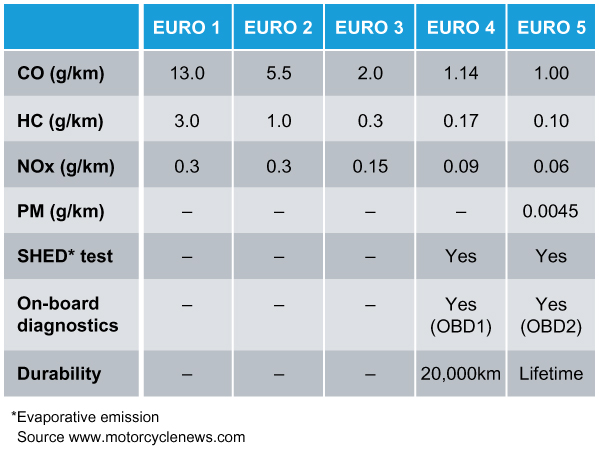Original article here:- https://www.infineuminsight.com/en-gb/articles/small-engines/euro-5-motorcycles/
Euro 5 motorcyclesCould Euro 5 emissions legislation mean the disappearance of two-stroke engines?
From January 1 2020, tough Euro 5 limits will apply to new motorcycles and mopeds. Designed to ensure this category of vehicles will pollute less, the regulation sets stringent limits for a number of tailpipe emissions that could be tough for two-stroke applications to meet.
Since 1997, the European Commission has been implementing Euro standards to reduce air pollutant emissions from two and three wheelers – known as L-category vehicles. The primary objective of this activity has been to reduce the share of total road transport emissions from these vehicles compared to other on-road sources. The first iterations of the regulation (Euro 1 to 3) focused on the reduction of hydrocarbons (HC), carbon monoxide (CO) and nitrogen oxides (NOx).
To ensure compliance, manufacturers have introduced more precise fuel injection and advanced combustion technologies to manage the fuel and added catalytic converters to treat the exhaust gasses. The protection of these sensitive catalysts has been a topic high on the industry agenda for some time.
In the future, some degree of lubricant phosphorus restriction or in-use performance targets for catalytic convertors could be required. However, on the lubricant side, there is a need to strike a balance with gear pitting performance, which currently sets a minimum lubricant phosphorus level.
Euro 4 and 5
In January 2013, Regulation (EU) No. 168/2013 expanded the number of L-categories and established implementation dates for future standards. Euro 4, which represented a huge leap compared to Euro 3, was introduced for all new motorcycles in 2017. To pass, bikes not only need to meet tougher emissions limits but also pass an evaporative emissions (SHED) test, run on-board self-diagnostic systems (OBD1), and prove they would still pass the tests after 20,000 km of service.
The next round of emissions cuts is on the horizon. Euro 5 is scheduled from 2020 for new motorcycles and for all L-category vehicles by 2021.
Here, along with a further tightening of CO, HC and NOx limits, we can expect the introduction of a new particulate matter (PM) limit of 0.045 g/km for all L-category vehicles.
However, once again the change does not stop at tightening emissions limits. The required Euro 5 performance must now be achieved under the new world motorcycle test cycle (WMCT) driving cycle – which is designed to represent typical driving conditions. In addition, the bike must be able to meet the Euro 5 requirements over its lifetime, which means a new style of on-board diagnostic system (OBD2) will be required. This will allow the bike to self-diagnose and self-correct to ensure emissions control is maintained.
Tightening Euro emissions limits

When we look down the Euro 5 parameters, particulate number (PN) limits are significant by their absence from the list. It appears that the regulators deem PM restrictions alone to be sufficient at this stage. This means that the widespread use of particulate filters on this category of vehicle is unlikely for the foreseeable future.
No CO2 or fuel economy mandates
Perhaps more of a surprise than the lack of any PN limits is that there appear to be no plans for the new Euro 5 standard to impose carbon dioxide (CO2) emissions limits or fuel economy performance targets. This is possibly because, when compared to other on-road sources, the CO2 contribution from motorcycles is very small. In addition, fuel economy targets would result in only small reductions in consumption, which would be unlikely to repay the regulatory effort required to introduce and enforce them.
To comply with the new Euro 5 regulation, CO2 emissions must be determined and fuel consumption calculated or measured.
Both must then be reported as part of the type-approval process and indicated on the certificate of conformity.
2-stroke demise
The tightening emissions limits and generally tougher requirements being introduced in Euro 5 will be very difficult for two-stroke (2T) applications to meet. This is mainly because 2T engine design allows some of the unburnt fuel/oil mixture to pass direct into the exhaust, producing high HC and PM emissions.
Direct fuel injection (DFI) is one option that is being looked at by some 2T OEMs - notably Honda and KTM - to reduce these emissions. However, it is not without its drawbacks. First, the injectors can be very expensive. Second, DFI engines can be prone to deposit build up behind the rings since they run hotter than conventional 2T engines. It seems likely that lubricants with strong dispersancy will be required to ensure their trouble-free operation.
Some manufacturers are developing catalysed high porosity wall flow particulate filters for two-stroke exhausts that, in addition to reducing CO and HC, also significantly reduce PM. The use of oils specifically formulated for 2T applications can also be used to help reduce PM emissions.
It is evident that changes in the motorcycle world are coming. It is unclear if readying 2T engines for Euro 5 will be more complex and costly than switching to four-stroke.
Perhaps this could finally mean the disappearance of 2T applications from the L-category altogether. Whatever the outcome, we can expect the change to create opportunities for the development of motorcycle-specific lubricants to support OEMs in the evolution of their equipment.
